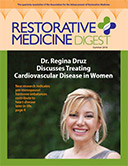Reactive oxygen species (ROS) are normal by-products of physiological and biochemical oxidative processes, such as mitochondrial respiration. A delicate balance between free-radical generation and intracellular antioxidants maintains healthy cell signaling and vascular function. An inordinate acute or chronic increase in intracellular levels of ROS, however, can overwhelm antioxidant capacity, leading to an imbalance in redox reactions known as oxidative stress. Oxidative stress is a major contributor to the aging process. It is also associated with the pathogenesis of numerous chronic health conditions including cancer, neurodegenerative disorders, and cardiovascular disease (CVD). Through a complex array of pathophysiological mechanisms that include vascular inflammation, endothelial dysfunction, and oxidative stress, oxidation of low-density lipoprotein (LDL) particles plays a key role in the development and progression of atherosclerosis.1,2,3
Supporting Redox Balance
The diet is an essential source of antioxidants that can help maintain redox balance. Of particular note, studies have found an inverse relationship between dietary consumption of nutrients high in polyphenols and CVD risk.4,5 Pomegranate (Punica granatum) is a rich source of multiple phenolic compounds that have high antioxidant and anti-inflammatory activity via several cellular pathways. Pomegranate juice and extracts derived from peel, seeds, and leaves have all been found to have beneficial properties.6 Pomegranate polyphenols have been shown to protect against LDL oxidation by scavenging reactive oxygen (and nitrogen) species. They also prevent macrophage foam cell formation by accumulating in arterial macrophages and inhibiting macrophage lipid peroxidation.7
Punicalagin, the most abundant and bioactive polyphenol constituent, is the main component of pomegranate peel. Punicalagin in particular has been shown to promote paraoxonase activity, which resulted in the hydrolysis of lipid peroxides in oxidized lipoproteins and atherosclerotic plaque.8 In an animal study, punicalagin prevented the development of high fat diet-induced cardiac metabolic disorders by upregulating mitochondrial biogenesis in cardiomyocytes and increasing phase II enzymes to reduce oxidative stress. This was accomplished via interaction with adenosine monophosphate-activated protein kinase (AMPK) and related signaling pathways. AMPK is the master regulator of lipid and energy metabolism and plays a key role in health and longevity.9
Pomegranate Extract and Cardiovascular Health
The beneficial impact that consuming pomegranate juice or extracts has on cardiovascular health has been corroborated by a small number of clinical trials.10 In a study of cardiovascular risk factors in 24 healthy volunteers, those receiving a standardized pomegranate extract three times a day for 28 days had statistically significant decreases from baseline in blood pressure (systolic and diastolic) and body fat/fat mass, as well as increased lean body mass when compared to the control group.11 In a study of ischemic heart disease, 100 patients who were hospitalized with unstable angina or myocardial infarction were randomized to receive usual care or usual care plus one cup (220 mL) of pomegranate juice a day for five days. The group given pomegranate juice experienced a significant reduction in the severity, frequency, and duration of chest pain, as well as in levels of serum troponin, a measure of myocardial damage, and malondialdehyde, a marker of oxidative stress.12
Clinical Implications
Polyphenols have antioxidant and anti-inflammatory properties through multiple molecular signaling pathways that are activated by oxidative stress. Inflammation triggered by oxidative stress is associated with aging and numerous chronic health conditions including CVD. Polyphenol compounds in pomegranate, particularly punicalagin, may have a unique affinity for biochemical pathways that modulate cardiovascular health. Given that an inverse relationship has been shown to exist between dietary intake of nutrients rich in polyphenols and CVD risk, supplementing with natural formulas that contain pomegranate constituents and increasing polyphenol-rich foods in the diet could be an important aspect of your overall therapeutic approach to patients who have CVD or are at risk of developing it.
References
- https://www.sciencedirect.com/science/article/abs/pii/S1537189115000427
- https://journals.plos.org/plosone/article?id=10.1371/journal.pone.0123088
- https://www.frontiersin.org/articles/10.3389/fphys.2017.00600/full
- https://www.ncbi.nlm.nih.gov/pmc/articles/PMC6266343/
- https://www.ncbi.nlm.nih.gov/pmc/articles/PMC7098940/
- https://pubmed.ncbi.nlm.nih.gov/31298147/
- https://pubmed.ncbi.nlm.nih.gov/12224378/
- https://www.mdpi.com/2076-3921/11/1/29
- https://www.nature.com/articles/srep14014
- https://pubmed.ncbi.nlm.nih.gov/32147056/
- https://www.mdpi.com/2076-3921/11/11/2124
- https://pubmed.ncbi.nlm.nih.gov/28913846/
